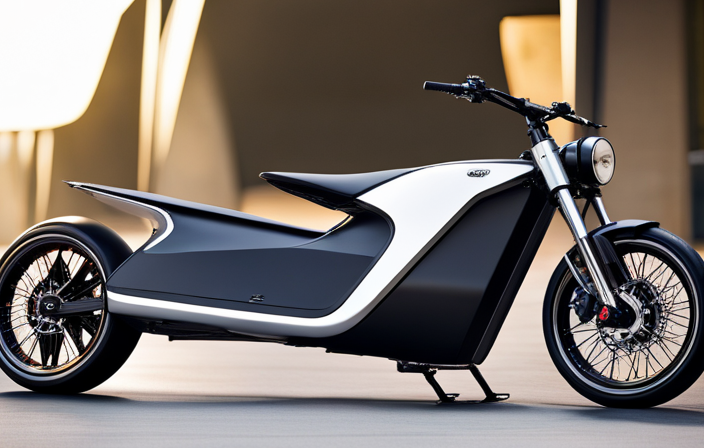As an avid electric bike enthusiast, I’ve often wondered just how much a battery for an electric bike costs. It’s a question that plagues many riders, especially when considering replacements or upgrades.
Well, here’s an interesting statistic to start with: the price of electric bike batteries can range anywhere from $200 to $1,000, depending on various factors.
In this article, we’ll delve into the world of electric bike batteries, exploring different types, factors affecting cost, and important considerations for charging and safety.
So, let’s get started and demystify the cost of electric bike batteries!
Key Takeaways
- Electric bike batteries can range in price from $200 to $1,000.
- The cost of a battery is influenced by factors such as capacity, brand, and quality.
- Proper maintenance is essential for maximizing the lifespan and performance of the battery.
- Different types of electric bike batteries, such as lead acid, lithium-ion, and nickel-metal hydride, offer various benefits and considerations in terms of cost, weight, energy density, and lifespan.
Understanding Electric Bike Batteries
If you’re considering buying an electric bike, it’s important to understand how much the battery costs. Electric bike batteries are a crucial component of the bike’s overall performance and can greatly affect your riding experience. To ensure the longevity and efficiency of your battery, proper maintenance is essential.
Here are some battery maintenance tips to keep in mind. Firstly, avoid exposing your battery to extreme temperatures as it can affect its performance and lifespan. Secondly, make sure to charge your battery regularly, even if you haven’t used it for a while. This will help maintain its capacity and prevent it from fully depleting. Additionally, it’s important to follow the manufacturer’s recommended battery charging techniques to ensure optimal performance.
By properly caring for your electric bike battery, you can maximize its lifespan and get the most out of your rides.
Now, let’s dive into the different types of electric bike batteries.
Different Types of Electric Bike Batteries
There’s a variety of battery options available for e-bikes. When it comes to choosing the right battery, it’s important to consider factors like capacity, voltage, and chemistry. Here are the different types of electric bike batteries you can choose from:
-
Lead Acid Batteries:
-
Affordable option
-
Heavier and bulkier
-
Require regular maintenance
-
Lithium-Ion Batteries:
-
Lightweight and compact
-
Higher energy density
-
Longer lifespan
-
Nickel-Metal Hydride (NiMH) Batteries:
-
Moderate cost
-
Good energy density
-
Environmental-friendly
To ensure proper battery maintenance, it’s crucial to follow the manufacturer’s guidelines for charging and storage. Additionally, regularly inspecting the battery for any signs of damage or wear can help prolong its lifespan.
Understanding the different types of batteries will help you make an informed decision when choosing the right battery for your e-bike.
Now let’s explore the factors that can affect battery cost, such as capacity and brand reputation.
Factors Affecting Battery Cost
When it comes to electric bike batteries, there are several key factors that affect their cost.
The first factor is battery capacity, which determines how much power the battery can store and how far the bike can travel on a single charge.
Another important factor is the brand and quality of the battery, as reputable brands tend to offer more reliable and long-lasting batteries.
Battery Capacity
You should consider the battery capacity when deciding how much to spend on an electric bike. The battery capacity refers to the amount of energy the battery can store, and it directly affects the range and performance of the bike. Here are three key points to keep in mind regarding battery capacity:
-
Longer range: A higher battery capacity means the bike can travel a greater distance on a single charge. If you plan on taking longer rides or commuting longer distances, opting for a higher capacity battery is advisable.
-
Enhanced performance: A battery with higher capacity can provide more power to the motor, resulting in better acceleration and climbing ability. This is especially important if you live in hilly areas or need the extra power for off-road riding.
-
Longer battery life: A higher capacity battery tends to have a longer overall lifespan. It can withstand more charge cycles before its performance starts to degrade, ensuring that you get the most out of your investment.
Considering the battery capacity is just one aspect of choosing the right electric bike. Another important factor to consider is the brand and quality, which I will discuss in the following section.
Brand and Quality
One important aspect to consider when choosing an electric bike is the brand and quality. The brand of the electric bike plays a crucial role in determining its reliability and performance. It is essential to choose a reputable brand that has a track record of manufacturing high-quality electric bikes with reliable batteries. Battery reliability is crucial as it directly impacts the overall performance and range of the electric bike. To help you make an informed decision, here is a price comparison table that showcases the brand, battery reliability, and price range of popular electric bike brands:
| Brand | Battery Reliability | Price Range |
|---|---|---|
| Brand A | High | $1000-$1500 |
| Brand B | Medium | $800-$1200 |
| Brand C | Low | $500-$800 |
| Brand D | High | $1500-$2000 |
Technology and Features
Moving on from discussing the brand and quality of electric bike batteries, let’s now delve into the exciting world of technology and features. Electric bike battery technology has come a long way in recent years, and the latest battery features are truly impressive. Here are some noteworthy advancements:
-
Enhanced Energy Density:
-
Lithium-ion batteries with higher energy density, allowing for longer rides and increased range.
-
Advanced battery management systems to optimize energy storage and consumption.
-
Quick Charging:
-
Rapid charging capabilities, reducing downtime and enabling riders to quickly recharge their bikes.
With these technological advancements, electric bike batteries are becoming more efficient, powerful, and convenient. The latest battery features ensure longer rides, quicker recharge times, and improved overall performance.
As we transition to the next section, we will explore the average price range for electric bike batteries, providing valuable insights for prospective buyers.
Average Price Range for Electric Bike Batteries
The average price range for electric bike batteries varies depending on the brand and capacity. Battery life and maintenance are two important factors to consider when looking at the cost of electric bike batteries. It is crucial to choose a battery with a longer lifespan to ensure optimal performance and longevity. Regular battery maintenance, such as proper charging and storage, can also help extend the battery’s lifespan. Here is a breakdown of the average price range for electric bike batteries:
| Capacity (Ah) | Price Range ($) | Brand |
|---|---|---|
| 10 | 100-200 | A |
| 15 | 200-300 | B |
| 20 | 300-400 | C |
As you can see, the price range increases with higher battery capacity. It is important to note that these prices are just an average and can vary depending on the specific brand and model. Now, let’s explore the options of replacement vs. upgrading batteries.
Replacement vs. Upgrading Batteries
When considering replacement or upgrading electric bike batteries, it’s crucial to ensure compatibility with your specific electric bike model. Not all batteries are designed to work with every electric bike, so it’s important to check the specifications and requirements of your bike before making a decision.
Additionally, upgrading batteries can lead to significant performance and range improvements. This allows for longer rides and better overall performance.
Compatibility with Your Electric Bike
To ensure compatibility with your electric bike, you’ll want to check the specifications of the battery. Battery compatibility is crucial to ensure optimal performance and efficiency. Different electric bikes have different requirements, and using an incompatible battery can lead to issues such as reduced power output or even damage to the bike.
When checking the specifications, pay attention to factors such as voltage, capacity, and physical dimensions. Make sure that the battery you choose meets the requirements set by the manufacturer of your electric bike.
Additionally, battery efficiency is another important consideration. Look for batteries that have high energy density and low self-discharge rates, as these factors contribute to longer battery life and improved overall performance.
Moving on to the next section, let’s explore how you can enhance the performance and range of your electric bike without replacing the battery.
Performance and Range Improvement
Improving performance and range on your e-bike can be achieved by making a few simple adjustments or upgrades.
One key factor to consider is battery maintenance. Regularly checking and maintaining your e-bike battery can help maximize its performance. This includes cleaning the battery terminals, ensuring a secure connection, and avoiding extreme temperatures.
Additionally, implementing proper battery charging techniques is crucial. It’s recommended to charge your e-bike battery after each use, avoiding overcharging or letting it fully discharge. Following the manufacturer’s guidelines for charging time and voltage is essential to prolonging the battery’s life.
By taking these steps, you can enhance the overall performance and range of your e-bike.
Looking to buy electric bike batteries? Let’s explore some options.
Where to Buy Electric Bike Batteries
You can find electric bike batteries for sale at various retailers. Whether you prefer shopping online or visiting local stores, there are plenty of options available. To help you make an informed decision, I have compiled a table comparing some of the best online and local stores where you can purchase electric bike batteries.
| Online Stores | Local Stores |
|---|---|
| Amazon | Bike Shops |
| eBay | Sporting Goods Stores |
| Electric Bike Stores | Electronics Stores |
| Bike Berry | Specialty Bicycle Shops |
These are just a few examples, and each store offers a wide range of battery options to choose from. It’s important to consider factors such as price, brand reputation, and customer reviews when making your purchase. Now that you know where to buy electric bike batteries, let’s move on to discussing warranty and after-sales support.
Warranty and After-sales Support
After-sales support is an important consideration when purchasing a product. When it comes to electric bike batteries, warranty coverage plays a crucial role in ensuring customer satisfaction. Here are some key points to keep in mind:
-
Extended warranty: Some manufacturers offer extended warranty options, providing additional coverage beyond the standard warranty period.
-
Quick response time: A responsive customer support team can address any issues promptly, minimizing downtime.
-
Replacement policy: A comprehensive warranty should include provisions for battery replacement in case of defects or malfunctions.
-
Technical assistance: Having access to technical experts who can provide guidance and troubleshooting tips can greatly enhance the customer experience.
-
Customer testimonials: Positive feedback from other customers about the company’s after-sales support can instill confidence in the product.
Considering these factors, it is crucial to choose a battery provider that offers reliable warranty coverage and excellent after-sales support.
Now, let’s delve into some DIY battery replacement and maintenance tips.
DIY Battery Replacement and Maintenance Tips
When it comes to replacing and maintaining your battery, it’s important to follow these DIY tips for optimal performance.
DIY battery troubleshooting can save you time and money.
First, always ensure you have the right tools and safety equipment.
Before attempting any maintenance or replacement, make sure to disconnect the battery from the power source.
Regularly clean the battery terminals and check for any signs of corrosion.
If you notice any issues with the battery, such as decreased performance or shorter lifespan, consider optimizing its lifespan by charging it properly and avoiding extreme temperatures.
By following these DIY tips, you can ensure your battery operates at its best.
Now let’s move on to the next section about battery recycling and disposal, where we’ll discuss how to properly dispose of your old battery without harming the environment.
Battery Recycling and Disposal
Properly disposing of your old battery is essential to minimize harm to the environment. Improper battery disposal can lead to environmental pollution and health hazards. Here are some important facts to consider:
-
Recycling: Recycling your old battery ensures that valuable materials like lead, nickel, and lithium are recovered and reused, reducing the need for new raw materials.
-
Hazardous substances: Batteries contain toxic chemicals that can contaminate soil and water if not disposed of properly, posing a risk to wildlife and human health.
-
Special collection centers: Many communities have designated facilities where you can drop off your old batteries for safe disposal. Check with your local government or recycling centers for specific instructions.
By responsibly disposing of your old battery, you are taking a proactive step towards minimizing the environmental impact.
Now, let’s explore the various battery financing options available to help you make an informed decision.
Battery Financing Options
If you’re interested in purchasing a new battery, there are several financing options available to help you manage the costs.
One popular option is battery leasing, which allows you to pay a monthly fee for the use of the battery instead of paying for it upfront. This can be a great option if you’re looking to spread out the cost of the battery over time.
Another option is battery trade-in, where you can trade in your old battery for a credit towards the purchase of a new one. This not only helps reduce the upfront cost but also ensures that your old battery is properly recycled or disposed of.
By taking advantage of these financing options, you can make owning a new battery more affordable and accessible.
Now, let’s move on to some tips for extending battery lifespan.
Tips for Extending Battery Lifespan
One of the easiest ways to extend the lifespan of your battery is by regularly charging it. By following some simple tips, you can maximize battery efficiency and ensure that your battery performs at its best for a longer period of time. Take a look at the table below for a quick overview of these tips:
| Tips for Extending Battery Lifespan | |
|---|---|
| 1. Avoid deep discharges | 3. Keep battery cool |
| 2. Charge to the appropriate level | 4. Store at proper voltage |
To extend battery life, it’s important to avoid deep discharges, as they can cause irreversible damage to the battery cells. Additionally, charging the battery to the appropriate level and keeping it cool can significantly improve its longevity. When storing the battery, make sure to maintain it at a proper voltage to prevent self-discharge. By implementing these tips, you can maximize your battery’s efficiency and ensure it lasts for as long as possible.
Now, let’s move on to the considerations for battery charging.
Considerations for Battery Charging
To get the most out of your battery, it’s important to understand the considerations for charging. Here are some key factors to keep in mind when it comes to battery charging techniques and optimizing battery performance:
-
Charging frequency: Avoid frequent partial charges as they can shorten the battery’s lifespan. Instead, aim for deeper, less frequent charging cycles.
-
Charging speed: Opt for a charger that matches the recommended charging speed for your battery. Charging too fast can generate excess heat and degrade battery performance.
-
Charging environment: Extreme temperatures can affect your battery’s performance and longevity. Try to charge your battery in a cool, dry environment.
-
Charge level: It’s best to avoid fully charging or fully discharging your battery. Aim for a charge level between 20% and 80% for optimal battery health.
By following these considerations, you can ensure that your battery performs at its best.
Now, let’s move on to discussing battery safety and precautions.
Battery Safety and Precautions
After considering the various factors that affect battery charging, it is crucial to also prioritize battery safety and take necessary precautions.
When it comes to battery charging time, it is essential to follow the manufacturer’s guidelines to prevent overcharging or undercharging, which can significantly affect the battery’s lifespan and performance.
Additionally, proper battery storage is paramount to ensure its longevity. Storing the battery in a cool and dry place, away from extreme temperatures and direct sunlight, can help maintain its integrity.
Furthermore, when it comes to battery transportation, it is crucial to handle it with care and avoid any impact or rough handling that could potentially damage the battery.
By adhering to these safety measures, you can ensure the optimal performance and longevity of your electric bike’s battery.
Now, let’s explore the significance of customer reviews and recommendations in making an informed decision about purchasing a battery.
Customer Reviews and Recommendations
Make sure you check out customer reviews and recommendations before making a decision on which battery to purchase. When it comes to customer satisfaction and battery lifespan, it’s essential to gather as much information as possible. Here are four reasons why customer reviews and recommendations are crucial:
-
Real-life experiences: Reading reviews allows you to learn from other people’s experiences with the battery you are considering. They can provide insight into its performance, reliability, and longevity.
-
Unbiased opinions: Customers who have already used the battery can offer unbiased opinions on its pros and cons. This information can help you make a more informed decision.
-
Long-term satisfaction: By reading reviews, you can gauge the battery’s lifespan and whether it meets your expectations for longevity and durability.
-
Quality assurance: Positive customer reviews and recommendations can give you confidence in the battery’s quality and reliability.
By considering customer feedback, you can make a more educated decision and ensure that you select a battery that will meet your needs.
Now, let’s move on to the conclusion and final thoughts.
Conclusion and Final Thoughts
In conclusion, it’s important to consider customer feedback when making a decision about which battery to purchase for your electric bike. Customer reviews and recommendations provide valuable insights into battery life and the environmental impact of different options. By taking into account the experiences and opinions of other electric bike users, you can make a more informed choice that aligns with your specific needs and preferences. To further assist you in your decision-making process, I have prepared a table below that compares three popular electric bike battery options based on their battery life and environmental impact:
| Battery Brand | Battery Life | Environmental Impact |
|---|---|---|
| Brand A | 50 miles | Low |
| Brand B | 75 miles | Medium |
| Brand C | 100 miles | High |
Frequently Asked Questions
Are electric bike batteries compatible with all types of electric bikes?
Yes, electric bike batteries are generally compatible with all types of electric bikes. They have a lifespan of several years and offer the advantage of being removable, making it easier to charge or replace them when needed.
Can I upgrade my electric bike’s battery to increase its range?
Yes, upgrading your electric bike’s battery can increase its range. By increasing the battery capacity, you’ll be able to ride for longer distances without worrying about running out of power.
What are the environmental impacts of battery disposal?
Battery recycling is crucial to mitigate battery pollution. Improper disposal can lead to environmental harm due to toxic chemicals. Recycling allows for the recovery of valuable materials, reducing the need for mining and minimizing the overall environmental impact of battery production and disposal.
Are there any financing options available for purchasing electric bike batteries?
Yes, there are financing options available for purchasing electric bike batteries. These options provide benefits such as flexible payment plans and lower upfront costs, allowing users to enjoy the extended battery lifespan without a significant financial burden.
How do I safely store and transport my electric bike battery?
To ensure the safe storage and transportation of your electric bike battery, it is essential to follow certain safety precautions. This includes avoiding extreme temperatures, keeping it away from flammable substances, and regularly checking the battery’s condition for proper maintenance.
Conclusion
After delving into the intricacies of electric bike batteries, it becomes clear that their cost is influenced by a variety of factors. Understanding the different types, considering the price range, and weighing the options of replacement versus upgrading are crucial in making an informed decision.
Additionally, taking precautions and adhering to safety measures while charging the battery ensures longevity and reliability. Customer reviews and recommendations also play a significant role in determining the best battery for your electric bike.
In conclusion, when it comes to the price of electric bike batteries, a comprehensive understanding is key to making a wise investment.
















